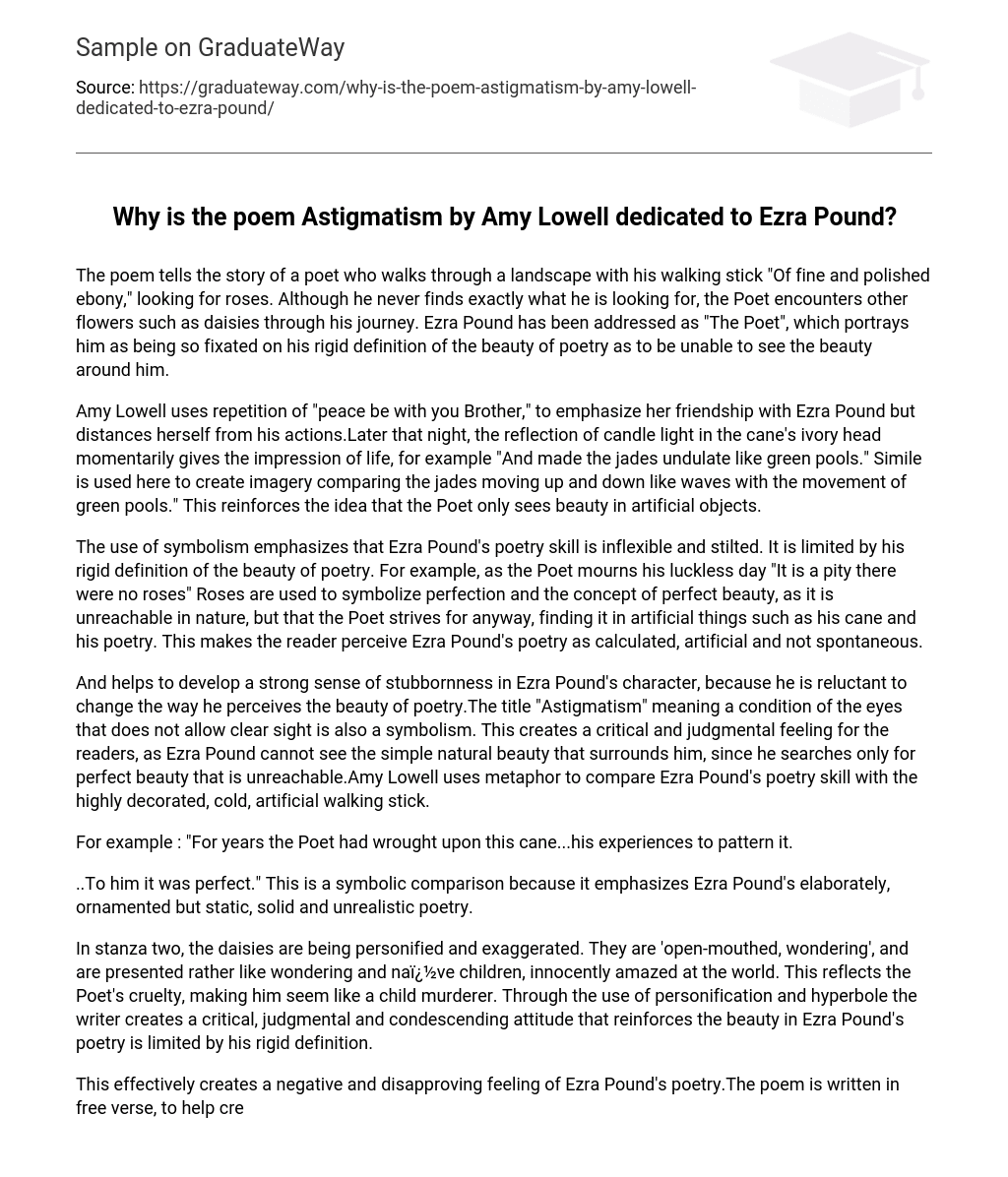The poem tells the story of a poet who walks through a landscape with his walking stick “Of fine and polished ebony,” looking for roses. Although he never finds exactly what he is looking for, the Poet encounters other flowers such as daisies through his journey. Ezra Pound has been addressed as “The Poet”, which portrays him as being so fixated on his rigid definition of the beauty of poetry as to be unable to see the beauty around him.
Amy Lowell uses repetition of “peace be with you Brother,” to emphasize her friendship with Ezra Pound but distances herself from his actions.Later that night, the reflection of candle light in the cane’s ivory head momentarily gives the impression of life, for example “And made the jades undulate like green pools.” Simile is used here to create imagery comparing the jades moving up and down like waves with the movement of green pools.” This reinforces the idea that the Poet only sees beauty in artificial objects.
The use of symbolism emphasizes that Ezra Pound’s poetry skill is inflexible and stilted. It is limited by his rigid definition of the beauty of poetry. For example, as the Poet mourns his luckless day “It is a pity there were no roses” Roses are used to symbolize perfection and the concept of perfect beauty, as it is unreachable in nature, but that the Poet strives for anyway, finding it in artificial things such as his cane and his poetry. This makes the reader perceive Ezra Pound’s poetry as calculated, artificial and not spontaneous.
And helps to develop a strong sense of stubbornness in Ezra Pound’s character, because he is reluctant to change the way he perceives the beauty of poetry.The title “Astigmatism” meaning a condition of the eyes that does not allow clear sight is also a symbolism. This creates a critical and judgmental feeling for the readers, as Ezra Pound cannot see the simple natural beauty that surrounds him, since he searches only for perfect beauty that is unreachable.Amy Lowell uses metaphor to compare Ezra Pound’s poetry skill with the highly decorated, cold, artificial walking stick.
For example : “For years the Poet had wrought upon this cane…his experiences to pattern it.
..To him it was perfect.” This is a symbolic comparison because it emphasizes Ezra Pound’s elaborately, ornamented but static, solid and unrealistic poetry.
In stanza two, the daisies are being personified and exaggerated. They are ‘open-mouthed, wondering’, and are presented rather like wondering and na�ve children, innocently amazed at the world. This reflects the Poet’s cruelty, making him seem like a child murderer. Through the use of personification and hyperbole the writer creates a critical, judgmental and condescending attitude that reinforces the beauty in Ezra Pound’s poetry is limited by his rigid definition.
This effectively creates a negative and disapproving feeling of Ezra Pound’s poetry.The poem is written in free verse, to help create images in the mind of the readers and to stimulate imagination and look beyond the words into a deeper meaning, where emotions such as anger and regret are being conveyed. For example, “The Poet struck them with his cane..
.They are useless. They are not roses.” If the poem was structured in a set way and forced into neat rhyme, it would lose the judgmental tone that pervades it without rhyme.
The lines in the poem vary in length to suit their subject. For example a short sentence such as “To him it was perfect” emphasize the Poet’s arrogance and stubbornness. A long sentence such as “Open-mouthed, wondering, they gazed at the sun” builds up details for the reader. These details build a picture of the daisy as innocent and na�ve.





